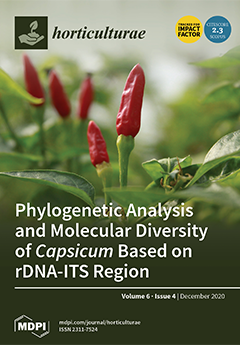Although goldenrod (
Solidago canadensis) is considered an invasive plant in many countries, it is a global cut-flower species. In addition, demand for goldenrod has increased significantly in recent years. Thus, the present study aimed to evaluate the response of
Solidago canadensis
[...] Read more.
Although goldenrod (
Solidago canadensis) is considered an invasive plant in many countries, it is a global cut-flower species. In addition, demand for goldenrod has increased significantly in recent years. Thus, the present study aimed to evaluate the response of
Solidago canadensis cv. Tara to brassinosteroids (BRs) at levels of 0.10
−3, 10
−6, and 10
−8 M, and chitosan at 0, 100, 150, and 200 mg/L as a foliar application to increase the quality and quantity of production, and its polyphenolic compounds. Moreover, antibacterial activity and genetic polymorphism for both untreated and the optimally treated goldenrod were investigated. The results showed that the highest mean of growth characteristics was found when plants were treated with BRs at 10
−8 M, whereas the longer vase life was obtained using 200 mg/L chitosan. Furthermore, higher pigment values, N, P, K, and total phenolic content, antioxidant capacity, chlorogenic acid, and rutin content were detected on plants treated with 200 mg/L chitosan. In addition, foliar application with 200 mg/L chitosan caused higher antibacterial activity among the control and BRs. The optimal treatment of BR at 10
−8 M (89%) showed a low genetic similarity, based on sequence-related amplified polymorphism (SRAP) analysis, comparable with the control and 200 mg/L chitosan. BR at 10
−8 M and 200 mg/L chitosan showed a significant enhancement of growth parameters. As a result, it can be concluded that goldenrod, as a herb extract, shows significant promise as a natural preservative in pharmaceutical, food, and cosmetic products.
Full article





